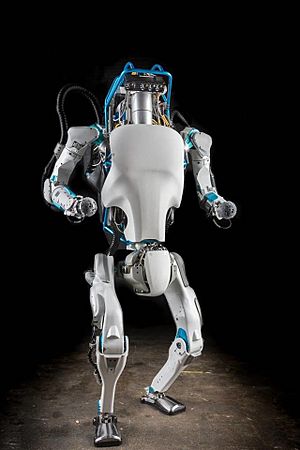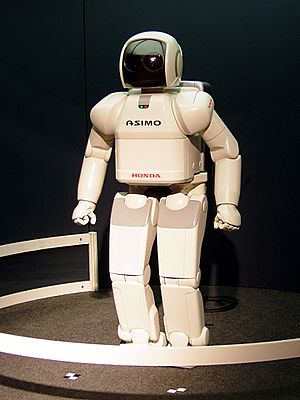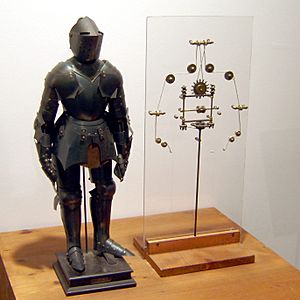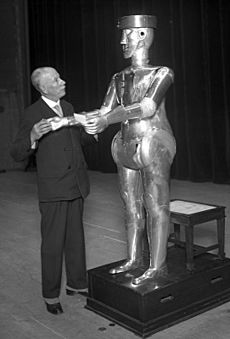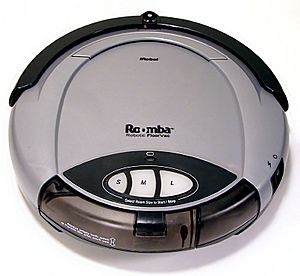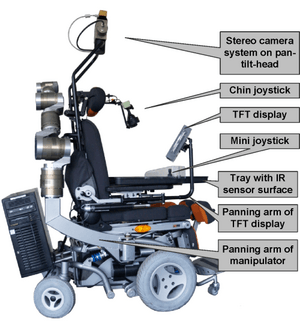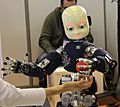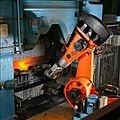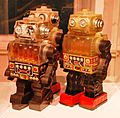Robot facts for kids
A robot is a machine that can do tasks on its own or with a little help. It acts like a helper, doing jobs it was built for. Robots are usually controlled by a computer program or electronic parts. Sometimes, people control them directly.
Some robots are made to look like humans. They might even seem to think or have feelings. But most robots do a specific job and do not look like people. They come in many different shapes and sizes.
The word 'robot' comes from a Slavic word meaning 'labor' or 'work'. It was first used for a fictional human-like machine in a 1920 play called R.U.R. by Karel Čapek. His brother, Josef Čapek, actually invented the word.
In stories, robots often look like people and seem to have their own lives. There are many books, movies, and video games with robots. I, Robot by Isaac Asimov is a very famous example.
Contents
How Robots Began
People have always been interested in building machines to help with work. But making these machines was expensive and took a lot of time. So, early ideas often stayed as drawings or were built just for fun.
Leonardo da Vinci designed a human-shaped machine in 1464. It looked like a knight and would have moved with ropes and wheels. Other inventors also drew mechanical people. In 1920, Karel Čapek wrote a play about them. He used a Czech word related to 'work' to name them: robot.
The most successful robots in the 1900s did not look like people. They were made to do practical jobs. George Devol created the first of these, called the Unimate, in 1954. It had one arm and one hand.
General Motors bought the Unimate in 1960. The next year, it started working in a factory in New Jersey. It lifted and stacked hot metal pieces that were too dangerous for people to touch. Engineers could program the Unimate and change its tasks when needed.
Robots Today

Robots are used for many different things today. Many factories use robots to do hard work quickly and accurately. These are called 'industrial' robots. They don't look like people because they are built for specific tasks.
Some robots find and remove bombs. If a mistake happens, the robot gets damaged instead of a person. There are also robots that help at home. They can vacuum floors or even mow lawns. These robots need to learn about the area they work in.
A few robots even help with surgery inside the body. They can reach places that are too small for a human hand.
Robots in Space
Planet rovers are robots that explore distant planets. It takes a long time for signals to travel from Earth to another planet. Because of this, these robots do most of their work on their own. They don't wait for commands from Earth for every step.
People still often imagine robots looking like humans, with two legs, two arms, and a head. ASIMO is a robot that helps scientists learn how to design and program robots. It can walk, which is a very difficult thing to program a robot to do.
Kinds of Robots
Here are some different kinds of robots:
- Aerobot – A robot that can fly on other planets.
- Android – A robot that looks like a human.
- Automaton – An early type of robot that did the same actions over and over.
- Autonomous vehicle – A car that can drive itself without a human.
- Cyborg – A being that is part human and part machine.
- Explosive ordnance disposal robot – A robot that checks for and removes explosives.
- Gynoid – A human-like robot designed to look like a female.
- Hexapod – A robot that walks on six legs, like an insect.
- Industrial robot – A robot used in factories to move things or do tasks.
- 3D printer – A machine that builds 3D objects layer by layer.
- Microbot – Tiny robots designed to go into the human body to help with diseases.
- Military robot – A robot used for military tasks, sometimes like a suit that makes a person stronger.
- Mobile robot – A robot that can move around on its own.
- Cruise missile – A robot-controlled missile that carries explosives.
- Nanobot – Even smaller than microbots, with parts measured in nanometers.
- Prosthetic robot – A robot arm or leg that replaces a missing human limb.
- Rover – A robot with wheels designed to move on other planets.
- Service robot – A robot that helps people with tasks, like guiding or cleaning.
- Snakebot – A robot that looks and moves like a snake, often to get into tight spaces.
- Surgical robot – A robot used for delicate operations inside the body.
- Walking robot – A robot that moves by walking. Two-legged robots are hard to balance, so many walking robots have multiple legs like insects.
How Robots Move
Mobile robots can also be grouped by how they move:
- Where they travel:
* Land or home robots: These usually have wheels or legs (like humanoids or animal-like robots). * Aerial robots: Also called drones or UAVs. * Underwater robots: Also called AUVs. * Polar robots: Designed for icy, cracked environments.
- What they use to move:
* Legged robots: With human-like or animal-like legs. * Tracks: Like on a tank. * Wheeled robots: Using wheels to move.
Robots Around the World
Robots in Asia
About half of all the robots in the world are in Asia. Japan has the most robots of any country and is a world leader in making them. Many people call Japan the "robot capital of the world."
In Japan and South Korea, people generally have positive ideas about future robots. This might be partly because of popular cartoon robots like 'Astroboy'. China also has similar positive views, but it is still developing its robot technology. Many people in East Asia believe robots should be almost equal to humans. They think robots could help care for older people, teach children, or work as assistants. They want robots to become more common and advanced.
A Japanese company, Mitsubishi, said, "This is the start of a time when humans and robots can live together." The South Korean government even predicted that every home in South Korea would have a robot by 2015 to 2020.
Robots in the West
Western countries are often more cautious or even afraid of robots. In science fiction movies and stories, robots are often shown as dangerous machines that turn against humans.
Some in the West see robots as a 'threat' to the future of humans. This view is partly influenced by religious beliefs. Some feel that creating machines that can think for themselves might be like 'playing God'. These ideas are not always clear, but there is a big difference in how robots are seen in the East and West.
Robot Rules
The writer Isaac Asimov wrote many stories about robots. In his stories, robots had "Three Laws of Robotics" to keep humans safe:
- A robot must not hurt a human being. It also must not let a human being come to harm by doing nothing.
- A robot must follow orders given by humans. But it cannot follow an order if it breaks the First Law.
- A robot must protect itself. But it cannot protect itself if it breaks the First or Second Law.
These laws were just ideas when he wrote them. But today, robots are becoming more complex. One day, real laws might be needed, much like Isaac Asimov's original three laws. These laws are even mentioned in the Megaman video games.
South Korea was the first country to create laws specifically about robots.
Related pages
- NASA
- Animatronics - using robotics to create puppets
- Navigation
- Vex
Images for kids
-
Articulated welding robots used in a factory are a type of industrial robot
-
A scene from Karel Čapek's 1920 play R.U.R. (Rossum's Universal Robots), showing three robots
-
TOPIO, a humanoid robot, played ping pong at Tokyo International Robot Exhibition (IREX) 2009
-
An android, or robot designed to resemble a human, can appear comforting to some people and disturbing to others
-
A U.S. Marine Corps technician prepares to use a telerobot to detonate a buried improvised explosive device near Camp Fallujah, Iraq.
See also
 In Spanish: Robot para niños
In Spanish: Robot para niños


